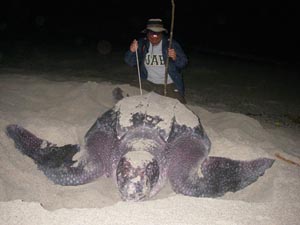TORTUGUERO, Costa Rica -- A sole pair of sea turtle tracks is all
that punctuates the serenity of sand along the protected beach on this
Central American country’s Caribbean side.
The
turtle made it out of the ocean to a preferred nesting spot -- but
never made it back. It was the first turtle researchers found killed by a
jaguar of the 2013 nesting season.
Tortuguero National
Park, in Costa Rica’s northern Caribbean slope region, has one of the
world’s most important nesting beaches for the endangered green turtle.
Scientists say 15,000 to 20,000 of them crawl ashore here each year for a
nesting season that lasts from May to October.
Even the
name Tortuguero is taken by some to mean "turtle area" -- yet it could
also translate as "turtle catcher" -- but this park is just one stop-off
in the creatures' epic migration from feeding spots to nest areas.
Now,
they’re sharing this quiet slice of paradise with a ferocious new
neighbor that’s making the mission harder for some to complete.
Tortuguero has become a hotspot for jaguars, the largest cat in the Americas, and they're proving to be nimble turtle catchers.
The
jaguar is a near-threatened species, according to the nonprofit
International Union for the Conservation of Nature's Red List of
Threatened Species; although, in some Latin American countries, jaguars
have vanished entirely.
Tortuguero park rangers say 10
years ago they never saw a jaguar on their beach. Now it’s virtually
crawling with them: Researchers say they’ve identified 16 jaguars in the
park, and estimate that the big cats kill about 1 percent of the
turtles nesting here.
Stephanny Arroyo, 31, who studies
wildlife conservation at the National University of Costa Rica, has been
researching the elusive cats for the past year, along with staff and
volunteers of Global Vision International (GVI) and support from the
national park and the nonprofit Panthera.
They set camera
traps at areas considered high-traffic spots for jaguars, which helps in
identifying and distinguishing the cats. But their photos and video
footage show more than just unique fur spots. Their findings reveal the
jaguars are acting unlike any jaguar these researchers have ever heard
of.
Jaguars, so happy together
Jaguars are known for living a solitary life, roaming a radius of at least 14 square miles by themselves.
Not
in Tortuguero. Here 16 jaguars are sharing 100 square miles, and, the
researchers say, they are oddly social: they eat together, travel
together and play together.
“I was certain that Tortuguero
was special for something,” Arroyo said. “The behavior [of the jaguars]
is unique and the quantity of individuals in such a small area is also
unique.”
One explanation under examination is the area's unusual abundance of
turtles. The bounty of turtle meat for half the year means jaguars might
not feel the need to compete for food, according to Arroyo. With
hunting made easy, these beasts could be less bothered to stake out
their own territory to roam solo.
“For example,” Arroyo
said, “to see two males walking together or three males walking together
is something that has never been seen before, or a male and a female
walking together is something that wasn't known.” In Tortuguero, she
said, that's what's happening.
Still, she and her
colleagues are working to get to the bottom of this. And the more the
jaguars amaze them, the more questions arise. Where are they coming
from? Where do they go when the turtles are gone?
Read original story in the Alaska Dispatch:
http://www.alaskadispatch.com/article/20130407/costa-rica-jaguars-feast-endangered-sea-turtles



